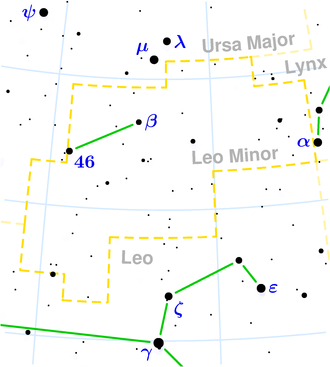IC 2606
| Galaxie IC 2606 | |
|---|---|
 | |
| SDSS-Aufnahme | |
| AladinLite | |
| Sternbild | Kleiner Löwe |
| Position Äquinoktium: J2000.0, Epoche: J2000.0 | |
| Rektaszension | 10h 50m 17,6s[1] |
| Deklination | +37° 57′ 22″[1] |
| Erscheinungsbild | |
| Morphologischer Typ | S0-a[1][2] |
| Helligkeit (visuell) | 14,0 mag[2] |
| Helligkeit (B-Band) | 14,9 mag[2] |
| Winkelausdehnung | 0,8′ × 0,3′[2] |
| Positionswinkel | 120°[2] |
| Flächenhelligkeit | 12,3 mag/arcmin²[2] |
| Physikalische Daten | |
| Rotverschiebung | 0.025768 ± 0.000063[1] |
| Radialgeschwindigkeit | (7725 ± 19) km/s[1] |
| Hubbledistanz vrad / H0 | (345 ± 24) · 106 Lj (105,8 ± 7,4) Mpc [1] |
| Geschichte | |
| Entdeckung | Stéphane Javelle |
| Entdeckungsdatum | 16. Mai 1903 |
| Katalogbezeichnungen | |
| IC 2606 • PGC 32465 • CGCG 184-025 • MCG +06-24-021 • 2MASX J10501764+3757221 • LDCE 0750 NED008 | |
IC 2606 ist eine linsenförmige Galaxie vom Hubble-Typ S0-a im Sternbild Kleiner Löwe am Nordsternhimmel. Sie ist schätzungsweise 345 Millionen Lichtjahre von der Milchstraße entfernt.
Das Objekt wurde am 16. Mai 1903 von Stéphane Javelle entdeckt.[3]
Weblinks
Einzelnachweise
Auf dieser Seite verwendete Medien
Autor/Urheber: Torsten Bronger, Lizenz: CC-BY-SA-3.0
This is a celestial map of the constellation Leo Minor, the Small Lion.
Autor/Urheber: Sloan Digital Sky Survey, Lizenz: CC BY 4.0
The sky image is obtained by Sloan Digital Sky Survey, DR14 with SciServer.
Angle of view: 4' × 4' (0.3" per pixel), north is up.
Details on the image processing pipeline: https://www.sdss.org/dr14/imaging/jpg-images-on-skyserver/



